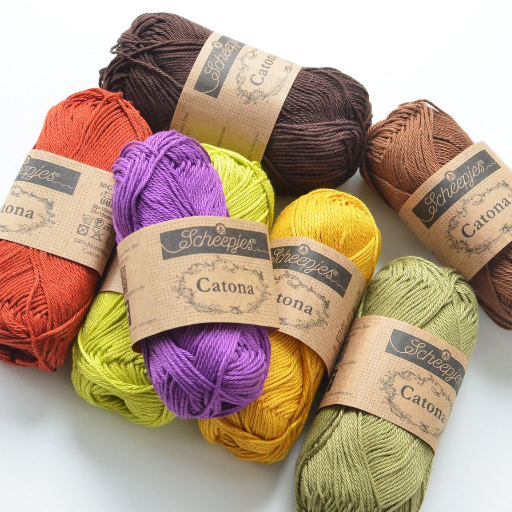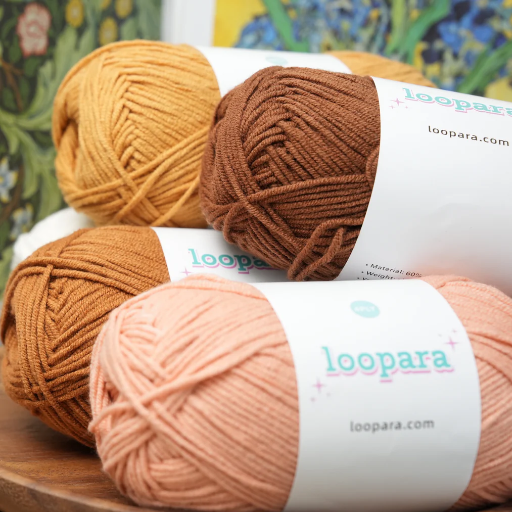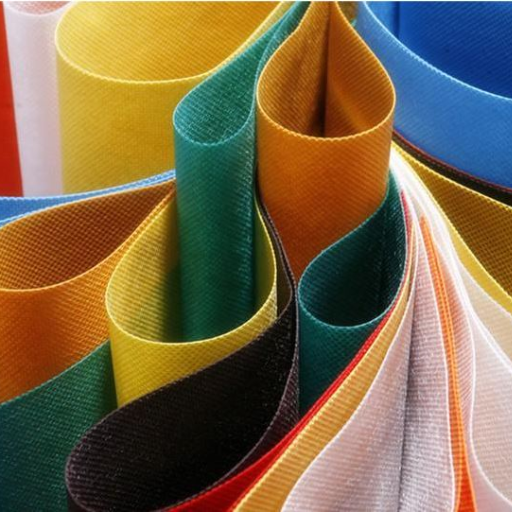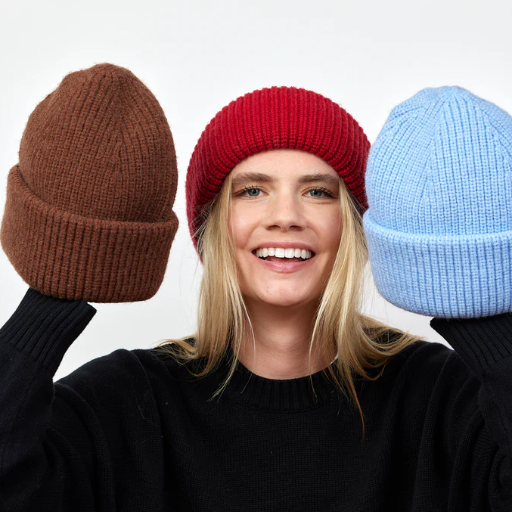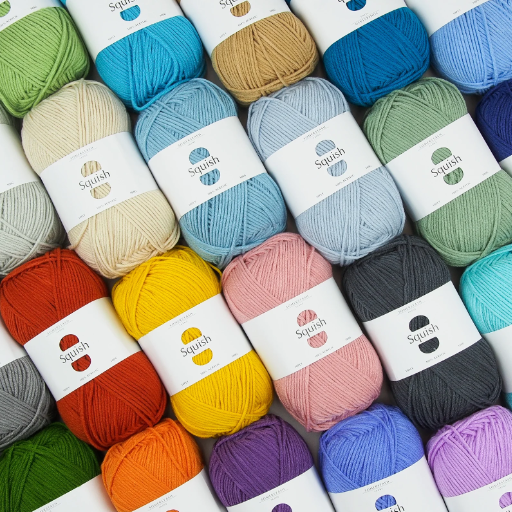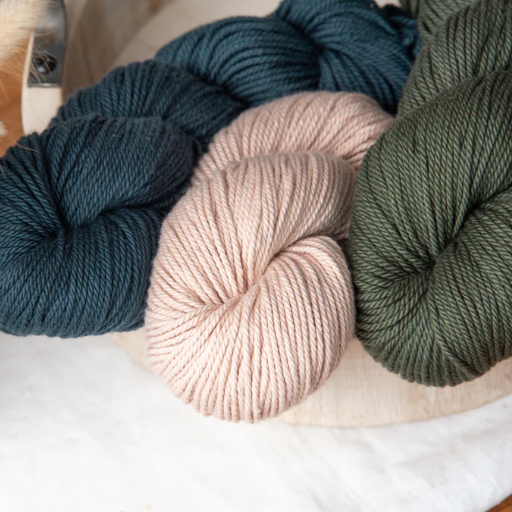The cotton-acrylic blend has a distinct place as one of the most reliable and flexible yarn types for any given project because of its multi-functional capabilities. As a detailed guide for cotton-acrylic yarn, this guide seeks to explain its characteristics, benefits and its most appropriate crafting applications. This article aims to inform the reader of the advantages of using cotton fibers alongside synthetic acrylic as well as stating what projects are best suited for “make it with acrylic” phrases. We will also look at how to care for and maintain cotton-acrylic yarn, protecting your creations while preserving quality over time. No matter your level of expertise, this thorough guide is bound to assist you in your next artistic project.
What is cotton acrylic blend yarn and why should you use it?

A cotton acrylic blend yarn combines the ease of use and low maintenance required in crafting with cotton’s breathability, softness, and moisture absorption. They also add the elasticity, strength, and lightness of acrylic. The resultant yarn possesses natural feel and synthetic strength. In addition to warmth, cotton gives a smooth texture, while the strong acrylic prevents wear, fading, and distortion over time. The resulting yarn is soft yet strong, making it ideal for numerous projects. The addition of acrylic also enhances the wear and tear resistance of shape and color retention after washing for decorative or functional pieces.
Understanding the composition of cotton acrylic blend yarn
Cotton acrylic blend yarn is soft and breathable because of the cotton, while the acrylic fibers add durability and elasticity. This combination creates a light, yet strong yarn that feels natural but lasts long. Acrylic strands make the fabric capable of withstanding changes in shape and color after many washes or uses, unlike natural fibers which easily lose such properties. Cotton blends are best for functional and decorative works. Moreover, cotton offers smooth absorption of moisture and softness while acrylic maintains resistance to wear, fading, and deformation. It is ideal for crafting garments, accessories, and household items because of low maintenance, along with versatility and adaptability to crafting methods.
Benefits of using cotton acrylic blend for crochet and knitting
- Durability and Strength
The blend of cotton and acrylic offers improved durability as it preserves the breathability of cotton and the strength of acrylic. Therefore, it is suitable for making garments and accessories that endure frequent use and maintain their shape over time.
- Softness and Comfort
Because of cotton’s natural feel, it is soft and comfortable, while acrylic provides a certain level of fluffiness and loft. Therefore, the end result is lightweight, warm, soft, and gentle on skin clothing items.
- Low Maintenance
Because of the cotton and acrylic blend, the items are easy to maintain since they are frequently machine washable and non-shrinking as well as fade-resistant. This blend makes caring for everyday garments and household items easy.
- Temperature Regulation
Cotton breathing allows comfort during warm weather, while acrylic keeps the user warm during cool conditions making the blend suitable for all seasons.
- Color Retention and Variety
Acrylic fibers are known for holding colors vividly, ensuring long-lasting hues which make the blend ideal for crocheted or knitted items. When blended with cotton, the result is bright and fades resistant goods.
The pieces offer a practical hard wearing solution and aids in expanding the creativity and artistic expression for novice and seasoned knit and crochet enthusiast making the blend ideal.
Comparing cotton acrylic blend to pure cotton and pure acrylic yarns
- Durability
Cotton yarns are softer in texture but can be prone to elongation and deformation, leading to potential damage over time. Alternatively, pure acrylic costly stretches and pilling, contributing to enhanced durability. Cotton and acrylic blends merge the softness of cotton and durability of acrylic which enhances the material’s longevity and resilience for prolonged usage.
- Texture and Comfort
The soft texture of cotton makes it breathable and moisture-wicking in warm climates while retaining comfort against the skin. More breathable materials like Acrylic meanwhile provide a smoother synthetic feel, though lacking in breathability. Together, they balance each other out, adapting cotton’s softness and elasticity alongside acrylic’s elasticity which makes the blend proficient in various fields from decor to textiles.
- Care and Maintenance
The properties of pure cotton denote that warm and gentle washing is needed to avoid damages like shrinking, while pure acrylic needs no special treatment as it is machine washable, fast-drying, and takes care of itself. Blends of the two attempt and oftentimes succeeded in providing a cotton feel while delivering care free acrylic attributes, making them suited for frequent cleaning.
- Cost Efficiency
The type of blended yarns is constructed from natural fibers and are thus more expensive, while budget friendly alternatives utilize purely synthetic materials like acrylic. These blended yarns come as a compromise, costing les while still keeping a dignity of quality, and serving as economical choices for crafters.
By blending cotton with acrylic, the dual advantages of both raw materials ensures achieving optimal attributes of functionality, comfort, and versatility for diverse knitting or crocheting projects.
How to choose the right cotton acrylic blend yarn for your project?

While thinking about which project to undertake next, think of the following considerations or practices when choosing a cotton acrylic blend yarn:
- Purpose of the Project: Whether the softness, breathability, or durability impacts the selected yarn most comes down to the intended use, whether it be clothing, accessories, or home items related decor.
- Weight and Gauge: The yarn weight and gauge should be aligned with the pattern expectations to achieve size and textural vision.
- Fiber Ratio: Verify the ratio between acrylic and cotton, more specifically the ratio of cotton to acrylic, to find a balance within the advantages. While most cotton increases ventilation, it is also less elastic, while more acrylic increases structure and strength.
- Warnings: check the laundering ease. For situations where the item will be washed often, look into the cleaning needs and wash parameters the yarn dictates.
- Design: Check for the shapes, colors, and textures that fulfill the project requirements and range of design options.
Analyzing the above factors would ensure that the yarn chosen meets the set requirements and also gets the desired results.
Considering yarn weight and gauge for your crochet or knitting project
Make sure that when choosing these characteristics the final objectives of the design work balance to the planned functional aspects. These aspects of padding and designing also consider the layering of fabrics. The width of the yarn is classified from lace as the lightest to jumbo which is the heaviest. Finer yarns are good for delicate detailing projects like lace shawls while textured warm garments like blankets are better off with bulky or jumbo yarns.
Gauge refers to the number of stitches and rows within a specific area of fabric, usually a 4×4 inch swatch. Gauge allows the knitter to achieve the intended dimensions and fit of the piece. The ratio of the blanked area to the worked area is determined by masking tape, weight and with indidiviusal tension. Make sure to block the unworked areas by doing a test swatch, that way all the requirements will be captured.
Selecting the perfect color and texture for your needs
Evaluate carefully the color and texture of your project in relation to its purpose and attraction after determining the intended color. Color harmonization is important; therefore, consider placement and how the item will be utilized. Reds and yellows are warmer tones and can invoke energy and vibrancy whereas blues and greens are cooler and promote calm. In texture, assess the feel of your materials. Smooth yarns will work for modern designs but chunky or textured yarns bring warmth and depth ideal for blankets and scarves. Follow the pattern requirements and check swatches in order to match your goals.
Understanding different brands and their cotton acrylic blend offerings
When selecting a cotton acrylic blend for your project, it is important to consider the distinct features presented by each brand and how they fit your project needs. According to leading sources:
- Lion Brand – Having blended cotton and acrylic in their offerings, Lion Brand stands out for its yarn versatility. Their Cotton Ease line exemplifies this, as it blends the softness of cotton with acrylic’s durability and elasticity. These blends are preferably light and strong materials, making them suitable for garments and home accessories.
- Bernat – Bernat provides economical, easy to find, cotton-acrylic combinations. Like with most of their products, Bernat Softee Cotton excels in softness and practicality giving great stitch definition which works very well for intricate patterns.
- Hobby Lobby’s I Love This Yarn! – This brand is well known for their premium-grade cotton-acrylic blends that have an incredibly smooth texture and great tensile longevity. It delivers a silky finish and is cherished for both beginner projects and advanced crafts due to its easy handling.
Each brand has distinct advantages and therefore, you should choose bearing in mind the requirements of your project, from texture to durability and intended use. As always, remember the care instructions, and make control test swatches to check for design objective compatibility.
What are the best cotton acrylic blend yarns for specific projects?

The greatest cotton-acrylic blend yarns will depend on your project goals because different blends offer specialized benefits.
- Garments and Wearables – Lion Brand’s “Comfy Cotton Blend” or Paintbox Yarns’ “Simply DK” are ideal for clothing like cardigans, sweaters, and baby clothes because they are soft yet durable and lightweight.
- Home Décor – Projects such as blankets, rugs, and other items that require high levels of decorative appeal and soft touch can utilize the “Bernat Handicrafter Acrylic Cotton Blend” from Yarnspirations because of its softness and strength.
- Accessories – Elaborate designs or bold patterns for scarves, bags, and hats are easily achieved using “Cotton Fair” by Premier Yarns since its soft texture allows for better color retention and stretch.
Regardless of design, any type of project requires that the yarn used is matched with the appropriate gauge, weight, and level of permanent color retention in order to achieve the desired level of functionality and aesthetics.
Top cotton acrylic blends for amigurumi and baby items
For amigurumi and baby items, acrylic blended cotton yarns are considered for their softness, durability, and ease of use. These creations require yarns that are soft while maintaining their rigid form and can stand up to frequent handling or washing. After analyzing top recommendations, I found the preferred options:
- Lion Brand Yarn – Coboo
For both amigurumi and baby projects, the most recommended blend is this supple soft yarn (Cotton 50% and Rayon 50%). The fiber content gives it lightweight, softness, and an air of breathability, making it perfect for very sensitive creations.
- Paintbox Yarns Cotton Aran
It is famous for its vibrant colors and makes high quality yarns. Cutomernat’s versatile 50/50 Blend of cotton and acrylic yarn is softness and strength. Customarnat is specially tailored towards crafting soft toys and baby clothes hence offers excellent value.
- Bernat Softee Baby Cotton
Hypoallergenic and easily machine washed, this yarn blend is perfect for creating soft and furry baby items. Consisting of cotton 60% and acrylic 40%, the yarn is super soft and durable, making it great for long lasting yet gentle projects.
This blend of yarns provides an ideal compromise between cotton and acrylic while ensuring it fits a wide range of creative and practical purposes.
Recommended yarns for garments and accessories
- Lion Brand Wool-Ease
Having 20% wool for warmth and and strength while giving 80% of the product to acrylic for softness makes this yarn extremely adaptable and flexible. Eblun knitting yarn is great for creating sweaters, scarves, and caps as they tend to be lightweight yet durable enabling them wash and wear repeatably for a long time.
- Debbie Bliss Cashmerino
For high end garments like cardigans or shawls this yarn is best as itEblun knitting yarn is crafted with precision from one of the finest blends of merino wool, cashmere and microfiber giving it luxuriously soft feel as well as superb stitch definition and smooth touch.
- Cascade 220 Superwash
Lightweight yet still 100% superwash wool, sock, glove and lightweight jacket knitters can now easily machine launder and maintain their pieces. The variety of colors given with the elasticity make it perfect for accessories and garments that are meant to be worn a lot like socks, gloves, and jackets.
Ideal cotton acrylic blends for home decor projects
- Lion Brand Yarn Coboo
The smooth finish guarantees an excellent professional outcome while the cotton-acrylic blend is perfect for soft home décor items like pillow covers, table runners, and throws due to their softness as well as the stretch that comes with acrylic.
- Paintbox Yarns Cotton Aran
Elongated use and ease of care define this yarn that combines cotton and acrylic. The practical blend in its structure ensures vibrancy and color, making it best suited for stylish and sturdy decorative baskets, dishcloths, and placemats.
- Knit Picks Comfy Worsted
Pima cotton gives soft towels and cozy home accessories a versatile feel with 25% acrylic while providing enhanced stitch definition. Durable elegance is guaranteed in projects that require long lasting beauty like afghans, decorative cushions, and curtains, establishing it as a go-to yarn.
How does cotton acrylic blend yarn perform in different techniques?

Cotton acrylic blend yarn provides an appropriate level of strength for almost every technique, and demonstrates notable versatility across a variety of crafting techniques. It excels in stitch definition whilst being used in knitting. As a result, intricate patterns such as lace and cables are beautifully crisp and definable. While crochet projects of softer items such as blankets are easy, sturdier projects like tote bags or baskets are also achievable due to the flexible structure this blend offers. This blend is also very efficient in performing colorwork as the vibrant hues do not fade considerably. Finished pieces crafted from this blend also undergo repeated washes and stretches retaining their structural integrity as a result of cotton’s breathability paired with acrylic’s strength.
Working with cotton acrylic blend in crochet projects
The appropriate thools and techniques help in achieving the best results while working with a cotton-acrylic blend in crochet projects. One should prefer the use of ergonomic or metal hooks which allow for smooth yarn movement, reducing the strain on muscles and allowing for constant consistency in tension. As this blends have great durability and flexibility, it can be used for a varity of stitches and detailed patterns along with structural elements efficiently. Its washable nature makes it extremely suitable for items which require grams washing such as home decor or baby garments. When blocking, use gentle methods such as steam blocking, for enhancing the form without compromising on the fiber’s integrity. Care labels provide vital information regarding specific washing instructions that will help prolong the longevity of your crochet creations, thus helping in maintaining their exquisite appeal.
Knitting with cotton acrylic blend yarn
The blend of acrylic and cotton yarn allows for soft and durable varieties of knits and is perfect for all kinds of projects because of its stretch. The smooth texture as well as the balance between the two materials means that blankets, clothing, and even accessories can be cleaned without significant wear. Cotton allows for breathability and comfort while the acrylic offers more elasticity and prevents the material from contracting during a wash. Remember to check the label and tenders pertaining the threads to ensure the items knitted do not have diminished quality and increased wear. Most important, match your needles to the flow weight and modify the tension to get ideal results.
Using cotton acrylic blend for other fiber arts
Beyond knitting, crochet, weaving, and macramé are also fiber arts that can benefit from the use of cotton acrylic blend yarn. Its balanced softness and breathability of cotton while its sturdiness and flexibility comes from acrylic means this blend is suitable for versatile projects. For crochet, it smooth texture permits lacework which is intricate to be worked with great detail. In weaving, the yarn serves as a stable base for both warp and weft and does not stretch nor break easily. In macramé projects, this blend holds the knots in place while being soft, making this blend ideal for decorative wall hangings or useful bags. Adjusting the tools, like hooks, to the specified project structure ensures best outcome. Piece durability is ensured by following label instructions regarding care.
What are the care instructions for items made with cotton acrylic blend yarn?

The care methods of cotton acrylic blend items done using cotton acrylic blend yarn involve gentle handling to preserve the items quality and extend its life. It is suggested to either use the delicate cycle on a machine with cold water or hand wash the items with mild detergent. Do not bleach or use abrasive cleaners as these will ruin the fibers. After washing, the item should be reshaped and placed flat so that it does not stretch nor distort. If the machine is to be used, gentle, low heat should be applied. For the best maintenance, the specific care label on the yarn should always be referred to.
Washing and drying recommendations for cotton acrylic blend items
Cold water should be preferred when washing cotton acrylic blend items along with a gentle cycle or hand washing. Bleaching and the use of strong detergents should be avoided to retain the fibers structural integrity. After these steps have been completed, the clothes should be reshaped back, and placed in a flat position for drying to avoid stretching. If a machine is being used, lower heat options should be used to avoid damaging the fibers. For best recommendations and instructions, check the packaging for details on the yarn care instructions.
Tips for maintaining the shape and softness of your finished projects
- Select the right method of storage: To avoid unnecessary distortion that may cause items to loose their shape, avoid hanging as well since it can misplace the fibers over time. Store items flat in a cool and dry place.
- Follow proper washing instructions: Always wash projects according to the yarn’s provided care instructions. For maintaining shape and softness, cold water and gentle detergents should be used. For detailed pieces, handwashing is the most suitable option.
- Careful drying: After washing, make sure to restore the items to their original dimensions and lay them down to dry. To soak up extra water, place a clean and dry towel beneath the item, but be sure not to block the view of the item.
- Neglecting ironing: Failing to apply proper heat when needed strongly weakens the fibers and lessens the softness. In cases where pressing needs to be done, use an iron with a low steam setting and always have a low heat barrier cloth placed over the iron to limit direct contact.
- Underscoring excessive wear: Gently rotating the use of handmade pieces while being mindful of heavy loads for long periods of time allow for day to maintain the item’s fabrics fabric without losing preservation over time. Conduct regular examinations to keep an eye on wear and make small adjustments and repairs for longevity.
Where can you find high-quality cotton acrylic blend yarns?

You can find high-grade cotton acrylic blend yarns at local and online craft specialty shops. Sit retailers like nitpicks, Love Crafts, and Yarnspirations offer brand name selections with fiber details and customer feedback. Local yarn stores may also have such blends, and usually provide helpful suggestions. Independant and Etsy sellers offer brand and marketplace items that are ethically made and environmentally friendly. Check the yarn fibers and grades of all the specifications to ensure they achieve the desired results for the crafting projects.
Popular brands offering cotton acrylic blend yarns
Well known brands sell yarns made of cotton and acrylic blend of different qualities. Popular brands already have varied options to choose from such as Lion Brand with its soft but strong Feels Like Butta collection. Bernat With Bernat Softee Baby brings us delicate projects while still being lightweight. Another trusted name Premier Yarns gives us smooth finished cotton fair along with a whole new range of colors. These brands are highly available in stores or other online shops making them easy for crafters out there.
Online and local yarn shops with great selections
There are several local and online shops that specialize in cotton acrylic blends. An example for larger stores is Yarnspirations.com, which has a wide selection from Patons and Bernat, and even suggests patterns for all skill levels. Another option is Lovecrafts. They offer a large collection of trustable brands alongside patterns that can be downloaded for free. WeCrochet is a wonderful site that specializes in curating yarns, tools, and items crafted for crocheters.
When it comes to local options, independent yarn shops tend to focus on community, fostering in-store connections while providing unique products. They are often rich in high-quality stock and have a large selection to choose from. Many stores offer in-person workshops which makes them invaluable to crafters who need closer guidance. Customers looking for specialized shops can use business directories or platforms such as the Fiberarts Map to find trustworthy shops around them.
References
Frequently Asked Questions (FAQ)
Q: What is cotton acrylic blend yarn, and why is it popular for crochet and knitting projects?
A: The cotton acrylic blend yarn is a combination of natural cotton fibers with synthetic acrylic fibers. This blend is well-known for its softness and breathability due to the cotton, as well as its durability and easy care because of acrylic. Because of these properties, it is best suited for many projects like amigurumi, baby items, and even wearables.
Q: How does cotton blend yarn compare to 100% cotton yarn for crochet and knitting?
A: Compared to 100% yarn, cotton blend yarn offers a few more benefits. For instance, pure cotton is one of the most breathable and soft yarn materials available; however, it can be heavy and stretchy. Blended yarns, like those with acrylic or polyester composites, maintain the soft, velvety touch of cotton while adding lightness and increased elasticity. This makes cotton blend yarn suitable for a wider range of projects, from amigurumi to wearables.
Q: What are the weight categories of cotton acrylic blend?
A: Cotton acrylic blend garments have different weights to accommodate varying project requirements. Some of the most common options are:
- DK (Double Knitting) or 3 weight yarn
- Worsted or 4 weight yarn
- Sport weight yarn
- Baby yarn which is mostly a lighter weight
These varying weights enable crafters and artists to meet the demands of different projects, whether it’s a sturdy piece of decor or a fragile baby item.
Q: Is cotton blend yarn suitable for making amigurumi?
A: Research shows that the primary concern many have around crocheting Amigurumi is the type of material used. Using a cotton blend yarn, for example, would be considered very effective for amigurumi. Mixing cotton with acrylic makes such a yarn rigid yet soft at the same time – especially useful for amigurumi that is stuffed. In addition, brands such as Alize Gold Gold are a favorite for crocheting amigurumi because they are strong and come in many colors.
Q: How does cotton acrylic blend yarn perform for baby items compared to other yarns?
A: In the case of producing baby items, a cotton acrylic blend knit yarn is highly functional. Cotton is soft and gentle on sensitive skin therefore blends of cotton yarn are soft and breathable. The acrylic, on the other hand, adds durability and makes it easy to care for. This makes the yarn ideal for baby blankets, clothes, and toys which get frequent washes. Because of its versatility, soft cotton yarn is popular among crafters for crocheting or knitting baby items.
Q: Can you recommend some popular brands of cotton acrylic blend yarns?
A: I can think of a few brands that sell good quality cotton acrylic blend yarns. Some popular options include: 1. Lion Brand’s Cotton Blend yarns 2. Alize Cotton Gold yarn 3. Estako Happy Cotton 4. Keche Cotton yarn 5. Comfy Cotton Blend yarn These brands provide different weights and colors which suit various needs from amigurumi to wearable projects.
Q: What is the difference between mercerized cotton and regular cotton in blend yarns?
A: Mercerized cotton possesses a certain treatment that gives it performed more silk-like in strength and lustrous than ordinary cotton. When blended with other fibers, mercerized cotton enhances the luster and strength of the cementing yarn mercerized cotton will, however, still take dye more readily and will produce bluer and more brilliant red shades than ordinary cotton. For products where a smart appearance is wanted, enhanced mercerized cotton blend yarns are preferred even though they are more costly.
Q: Are there any special care instructions for items made with cotton acrylic blend yarns?
A: Adding cotton to the acrylic yarns makes them easy to care for, however, we recommend to abide by 1. Machine washing in a gentle cycle in warm or cool water. 2. Using a mild detergent to protect the fibers. 3. Not bleaching since it weakens the acrylic component. 4. Tumble drying on low heat or laying flat to dry. 5. If ironing is required, use a low heat setting and be cautious of the acrylic content. Yarn care label instructions must be followed, especially when the brands and blends differ.








